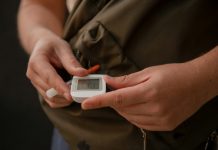
Obesity is the main cause of type 2 diabetes and many other chronic illnesses.
In a recent study from Harvard Medical School, scientists found proof of concept for a novel cell-based therapy against this dangerous health condition.
The new therapy for obesity would transplant HUMBLE (human brown-like) fat cells, human white fat cells that have been genetically modified to become similar to heat-generating brown fat cells.
Brown fat cells burn energy instead of storing energy as white fat cells do.
In the process, brown fat can lower excessive levels of glucose and lipids in the blood that are linked to metabolic diseases such as diabetes.
However, people who are overweight or obese tend to have less of these beneficial brown fat.
In the current study, the team created the cells from human white fat cells in a progenitor stage (not yet fully developed into their final fat form).
They used a variant of the CRISPR-Cas9 genome editing system to boost the expression of a gene called UCP1, which triggers white fat cells to develop into brown fat-like cells.
Transplanted into mice lacking an immune system, the new HUMBLE cells developed into cells that functioned very much like the mice’s own brown fat cells.
The team compared transplants of these cells versus the original white fat cells in mice who were put on a high-fat diet.
They found mice given the HUMBLE transplants displayed much greater sensitivity to insulin and the ability to clear glucose from the blood (two key factors that are impaired in type 2 diabetes).
Additionally, the mice receiving HUMBLE transplants put on less weight than mice with transplanted white fat cells, remaining in the same range as animals who received brown fat cells.
Perhaps surprisingly, the scientists demonstrated that these benefits were mostly due to signals from the transplanted cells to endogenous (existing) brown fat cells in the mice.
If the HUMBLE technique continues to prove out in pre-clinical research, it might eventually be possible to generate this type of cell for patients.
Such a procedure would remove a tiny amount of a patient’s white fat cells, isolate the progenitor cells, modify those cells to boost the expression of UCP1, and then return the resulting HUMBLE cells to the patient.
The team emphasizes that this research is moving ahead despite the COVID-19 pandemic, which puts people with diabetes at a much higher risk of serious outcomes if they are infected.
If you care about diabetes, please read studies about the best way to achieve type 2 diabetes remission and a new cure for type 2 diabetes.
For more information about health, please see recent studies about nutrients that could help reduce the risk of type 2 diabetes, and results showing how to lose weight through exercise.
The research was published in Science Translational Medicine and conducted by is Yu-Hua Tseng et al.
Copyright © 2022 Knowridge Science Report. All rights reserved.



